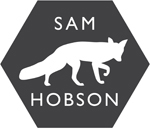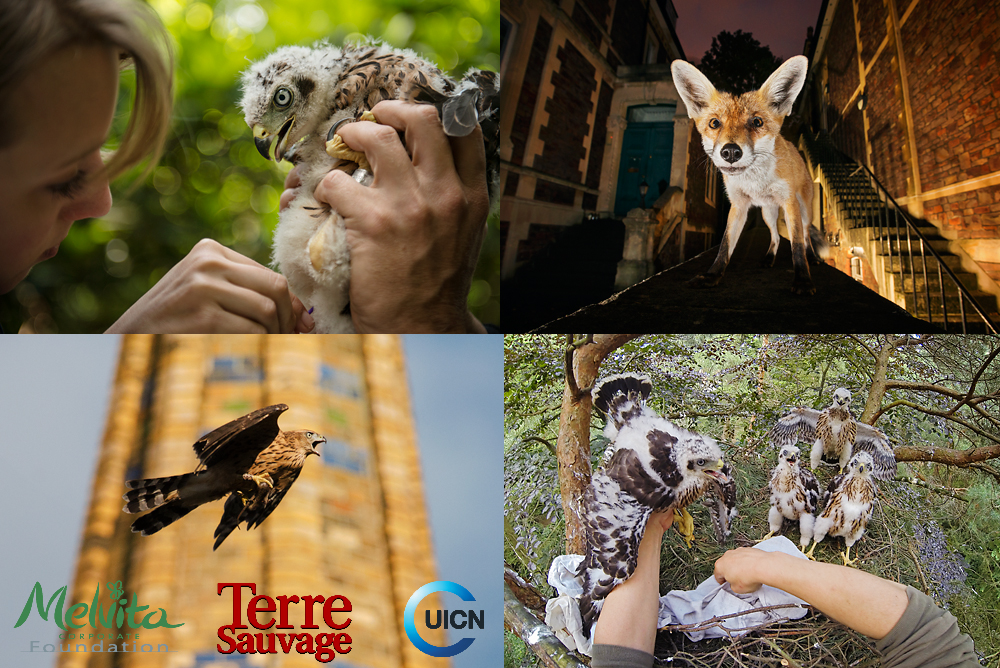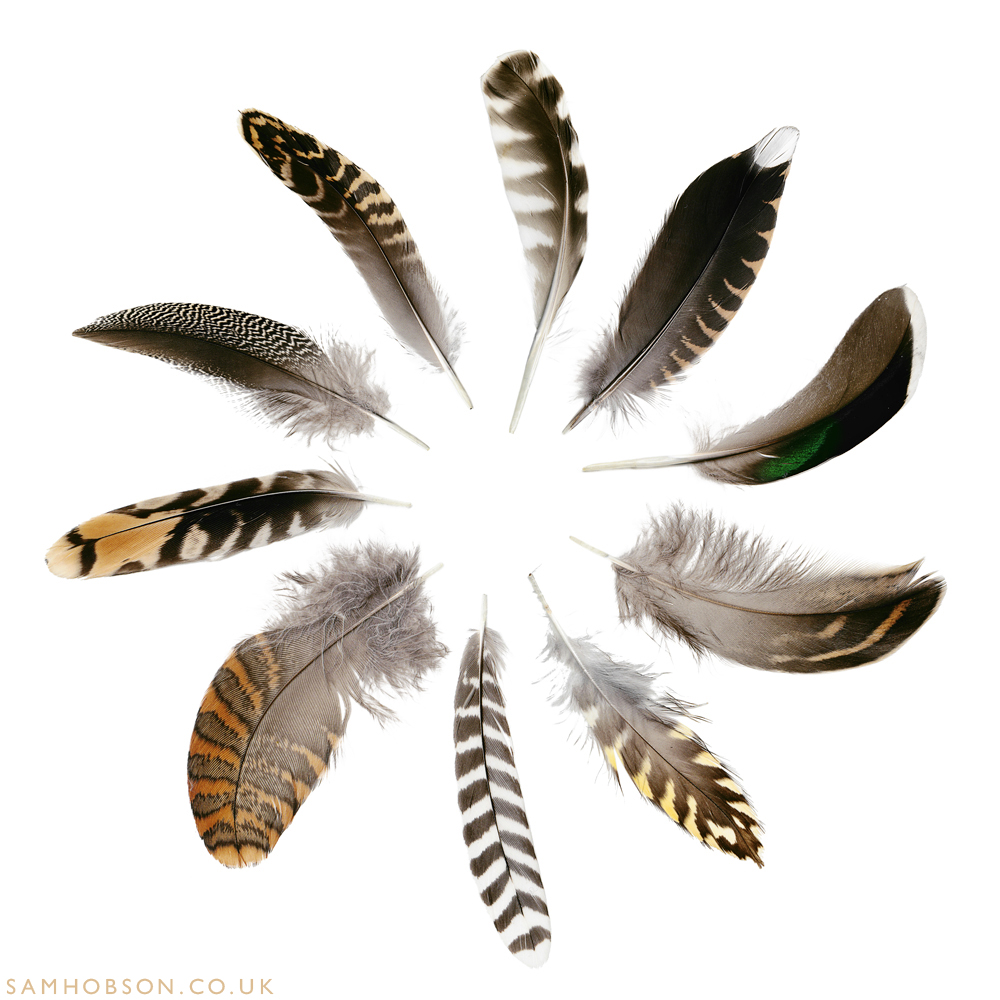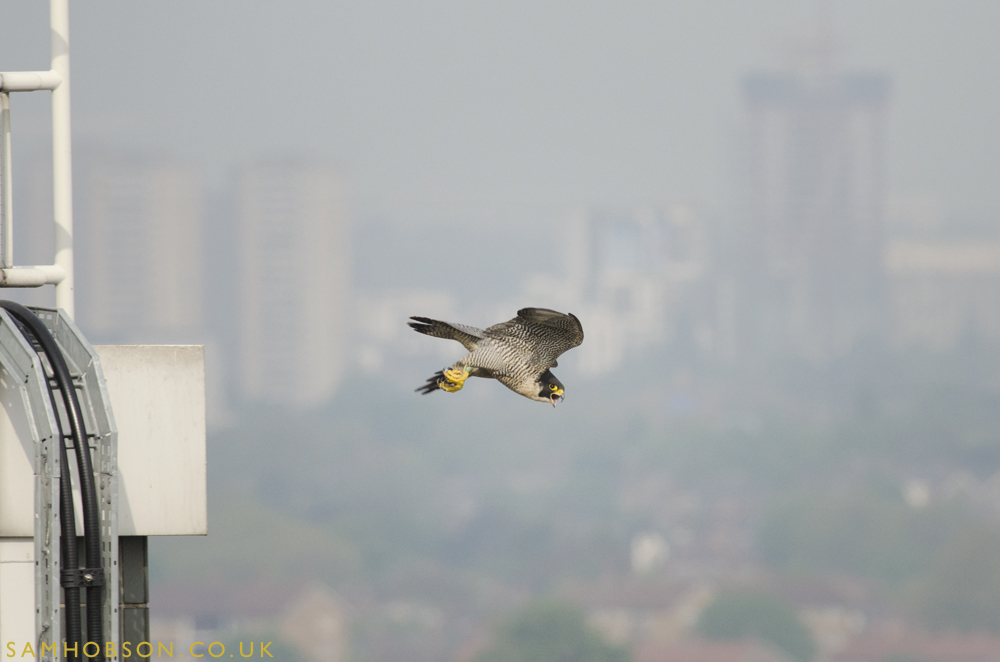BBC Wildlife Magazine (October 2015) has just published my gull feature, which I've been working on for the past couple of years. It follows a summer of hysteria in the British media about gulls attacking people and their pets and hopefully provides a refreshingly accurate take on the situation which looks at the latest research and science and interviews experts in the field - many of which I've had the privilege to work with during the project. We published the feature early due to the media frenzy this summer, so I'm still working on the project, but these are some of my favourite pictures that either made the feature or will hopefully be published when the project is complete.
PROJECTS
NATURE'S IMAGES AWARDS 2014
The results of the 2014 Melvita Nature's Images Awards have just been announced this morning and my recently published Berlin goshawk story and one of my urban fox pictures have both been awarded. The goshawk set (12 images) was a runner-up in the Man and Nature category and my fox in the Nature in the City category. A nice way to finish off 2014 and my best year so far in the major wildlife photography competitions with a total of 21 awarded images.
You can see all of the winners and runners-up on the competition website: www.natureimagesawards.com/palmares-2014
In unrelated news, my parakeet image has been included in the Daily Mail's "Most Amazing Photographs of 2014". View the full selection here.
BBC WILDLIFE MAGAZINE - URBAN GOSHAWK FEATURE PUBLISHED
The latest issue of BBC Wildlife Magazine (January 2015) hits the shelves on Monday and I'm excited to share that it's running my Berlin goshawk story. I've been working on this for some time now and it's been a bit of a journey from my first trip out to find them at the beginning of 2013. I've met lots of people working with goshawks and raptors along the way and some have become close friends. I took Ben Hoare, the features editor of Wildlife Mag out to Berlin with me this Summer to meet some of them, so that he could find out a bit more about the project and interview the people working with and monitoring the goshawks before writing the feature. 2015 is the "year of the Goshawk" in Germany, so it's a great time for it to be published and Ben has done a great job in telling the full story. Subscribers to the mag should have their copies already, but it officially goes on sale on Monday 22nd December so please go and check it out.
You can see more of my pictures from this project on my site: www.samhobson.co.uk/urban-goshawk
A web gallery is also being featured on the BBC Discover Wildlife Site: www.discoverwildlife.com/gallery/goshawks-berlin
The behind the scenes video on the Wildlife Mag Youtube Channel is here: http://youtu.be/d2tboE0fePw
Massive thanks to Norbert, Bea, Rainer, Olly, Manuela, Lutz, Felix and all the guys who helped me get the pictures and made it so much fun and big thanks to everyone at Wildlife Mag for making it happen!
GOSHAWK PICTURES USED FOR BIRD OF YEAR CAMPAIGN 2015
It has just been announced that the goshawk (der habicht) will be pronounced "Bird of the Year" for 2015 in Germany. I have been out to Berlin a number of times to photograph the urban population of goshawks, so I'm pleased that NABU will be using my pictures for their campaign. It's really great to see this often persecuted bird of prey being championed and and brought into public awareness. They are using one of my images for the poster and you can also download a brochure with loads of information (in German) and some of mine and my friends pictures here: http://www.nabu.de/aktionenundprojekte/vogeldesjahres/2015-habicht/17210.html
NEW URBAN FOX PROJECT
I've been working locally in Bristol recently on a new fox project, to get some new images together for my upcoming talk at Wildscreen Photography Festival. The beauty of working locally is that it means I can visit a site regularly and be a bit more creative with my lighting and set up. I've been working with a local family of foxes that are all really individual characters, but my favourite to photograph by far is this little guy who is just so inquisitive and cheeky. I've tried to capture some of his personality in my pictures. You can see the full set here: www.samhobson.co.uk/urban-red-fox
Both shot on Nikon D800, Nikon 17-35mm f2.8, SB-800, SB-700, Pocket Wizard +IIIs
URBAN PEREGRINE FALCON PROJECT
A portfolio of my peregrines is currently up on the BBC Wildlife Magazine website, featuring some of the images I've been working on for the past 2 years, so I thought I'd take the opportunity to write a bit about the project.
My relationship with peregrine falcons has been a long one. I can't remember my very first encounter, but I remember becoming aware of them when I was studying wildlife photography at university in Blackpool. During the term, I'd occasionally see them on the church in the town centre or perched near the top of "The Big One" at Blackpool Pleasure Beach - the world's tallest rollercoaster at the time. Always at a distance, I wasn't sure that I'd ever be able to photograph them. I first witnessed one hunting on a field-trip to Heysham Bay, where 50,000 knot would roost at high tide. Without warning, a large falcon appeared out of the blue and piled into the roosting birds, causing pandemonium. The knot twisted and turned, splitting into aerial spheres of thousands of birds before coalescing into a tight mass, all the while with the peregrine stooping and chasing until it secured a victory. Another memorable encounter was when an adult bird smashed through one of the large double-glazed university windows - presumably unable to pull out of a high speed stoop after a local pigeon. It was a sad sight to see such an electrifying creature suddenly so still and lifeless, but as most of the scientific illustration course's models were getting a bit old and tatty, the college had it stuffed and it became immortalised in ink and paint.
During the Summers, I worked on a boat in South Devon that went on wildlife cruises from the Exe out in to Lyme Bay and the Jurassic Coast. We'd see peregrines nearly everyday and this is when I started to get my eye in, and learnt to quickly pick out their shape against a blue sky or a cliff face.
Since then, I have always looked out for them in likely spots and in any city that I visit, I watch the pigeons for the tell-tale behaviours that give away a patrolling peregrines's presence in the sky above.
But it wasn't until I moved to Bristol in 2010 that I got to know a particular pair of peregrines intimately, learning their daily habits and routines. I moved in to a flat in Clifton between the Wills Memorial Building and Cabot Tower, keeping my eye on the Wills Building as it looked perfect for a peregrine. It wasn't long before I was rewarded and I started to see them regularly - I could even hear the occasional screech, kak or ee-chup if I left my window open.
On a dark night in November 2011, I stepped out for a walk and could hear the male calling loudly. I'd heard about peregrines using city lights to hunt nocturnally, but I never thought I'd see it for myself. I rushed over to the base of the building and saw a bird in the sky, glowing in the tower's up-lights. It was the female with a kill. It was late, so the streets were quiet, which meant I could run about in the road like a mad-man to try and catch the plucked feathers as they fell. They'd caught a lapwing migrating under the cover of darkness - not a common bird to see in the middle of the city. I was totally blown away.
After this encounter, I started to get interested in the urban peregrines' diet - they could show us exactly what unusual birds were flying over our heads while we were tucked up in bed. I began monitoring the Clifton pair and my other local pair in the city centre, and started to discover all kinds of curious goings-on. Whimbrels, woodcocks, cuckoo, golden plover, water rail, little grebe, dunlin, jack snipe, skylark and teal were all on the menu - and none of them city birds. You would think that peregrines living in the city would just prey upon the pigeons, but during some Winter months, pigeons were making up much less than a third of their diet. They were hunting nocturnal migrants almost exclusively. I guess why go after a street-savvy feral pigeon, that knows the city like the back of its wing, when you can pluck a tasty game-bird out of the sky? I realised Bristol was pretty well located for passage migrants - frozen ground or snow cover in the north would push them to the milder south-west.
My peregrine watching became a round-the-clock pursuit and I'd take any opportunity to stop in and see what I could find in the prey remains. Some times it would just be a feather or a foot, but occasionally after a storm, I'd find the peregrine's winter cache completely washed out. There'd be wings, legs, whole bodies and one time, even 3 whole woodcocks lying in the street in the centre of Bristol. It's pretty difficult to ID bird remains, even if they are whole - a lifeless lump taken out of context is surprisingly unfamiliar when you don't have behaviour and habitat to help. I asked a man well known for his peregrine studies - Ed Drewitt, for help and we became friends, brought together by a morbid fascination for bird bits. He taught me loads, and even though I am now able to identify most of what I find, I still have to go to him with the more unusual stuff. Ed has been studying urban peregrines for the last 15 years and has recently written a book about them, which will feature a lot about their diet and around 20 of my pictures, including this one on the cover - perhaps one of the best looking peregrines out there, the Bristol city centre tiercel.
As I spent more and more time learning about the peregrines' habits and behaviours, my pictures started to improve and I started to learn to predict when they would be active and where to be to best see and photograph them. Peregrines might be the fastest animal on the planet, but they can also be the slowest - particularly after a meal. You can literally wait 5 hours for 30 seconds of action, so learning to anticipate their behaviours has been pretty useful, if not for anything else than to save me getting cold and restless.
The picture above is a good example - it was a cold Winter's morning, after a period of rain during which this family's food cache had been lost, so I knew they were hungry. The solitary juvenile from that year's brood was still hanging around, begging and being tolerated and I knew the adult male had a sneaky half pigeon stashed away on a different building to their normal cache site. It was only a matter of waiting for him to sneak off and fetch it, which as soon as he did caused the other 2 to chase him until he gave it up - it might look like a food transfer, but in this case, that was the last thing on the tiercel's mind.
Below is an image of the same Bristol family - this juvenile male was always playing with his food, and here he's practicing flying whilst carrying the weight of a butchered pigeon. I like the way it shows his tail feathers spread open for extra lift and you can just make out his mother, keeping a watchful eye on him from the building behind.
Through working with peregrines, I've had the opportunity to meet and get to know others who share the same passion, which has led to some great photographic opportunities, including ringing the nestlings around Bristol and Bath, again with Ed Drewitt.
Probably my most memorable experience though, was watching the peregrines at Charing Cross Hospital being ringed. Urban peregrine falcon photography can be tricky as you're always looking up and it's sometimes difficult to get that urban context - a peregrine with a cityscape in the background is like the holy grail! Nathalie Mahieu, who monitors the family there gave me the chance to come along and take some pictures during the ringing. I was pretty excited, as we'd be up near the top of the hospital, looking out over a busy London skyline. That morning the sun had just started to peek through the clouds as we went up towards the roof to access the scrape and by the time we got up there, there was just enough light to get the shutter speeds I'd need to capture the birds in flight.
You never know how the parents will react when the chicks are being ringed. Sometimes they will just disappear, occasionally they will react at first, then settle down and watch from a distance - particularly if they have had their chicks ringed before, and sometimes they will remain vigilant and agitated - flying backwards and forwards, calling as they closely watch the proceedings.
After about 15 minutes the whole thing is over and it's as if nothing ever happened, but those 15 minutes can be pretty productive if you can hold your nerve and not panic when there's an adult peregrine falcon buzzing past just metres from your head.
I haven't quite finished with the peregrines and I still monitor my local pairs regularly, but now I'm mainly working on an urban goshawk project, that should be complete by the end of the Summer, so watch this space :)
You can see more from my urban peregrine project on my portfolio site.
Ed's book is out in May, and can be pre-ordered at the Natural History Book Store.
I'd like to thank fellow peregrine people - Ed Drewitt, Nathalie Mahieu, Terry Pickford, Stuart Harrington and Dave Morrison for their help and advice and fellow photographer Bertie G for keeping me on my toes with his many exclamations of "urban peregrine, comin' in hot!!!"..
STAG NIGHTS
After discovering the urban deer site I mentioned in my last post, I couldn't wait to get back and spend a bit more time photographing them. After previously visiting on 3 different nights and only having any luck once, I knew I'd need a few days to get anything decent, so I bit the bullet and decided to book into a nearby hotel to maximise my opportunities. I'd already learnt a bit about the particular spots the deer liked to feed and the routes they used to venture out of the woods and into the urban surrounds, so starting off, I was in a good place to get in position as soon as they appeared..
Peering out from the edge of a copse, they'd wait for things to quieten down - usually around 2 o'clock before making a break from cover and dashing into the city.
By around 3 o'clock they'd find a quiet spot with a nice bit of grass to feed on and start to settle down. Gradually the bolder ones would venture into the busier streets, only dashing into the shadows when a car or bus went by.
The larger herds stuck to the playing fields, where they were less likely to be disturbed.
On my first attempts, my pictures looked a little grainy, so I decided to use a lower ISO this time and took things down to to around 400-640. This got rid of the noise, but meant that I needed shutter speeds of between 0.5 and 3 seconds at f2.8, but I had a tripod and a bean-bag so I was good to go. Deer are the perfect subject for slow shutter-speeds - often between feeds, raising their heads and staying stock-still to watch and listen for danger.
The trick is definitely to get in front of them, get your shot ready and wait for them to walk into frame. Chasing them around just doesn't work. They are always on high alert and remain skittish, so you need to be quietly patient and just hope that it all comes into place.. Like when a full-grown buck walks out into the street, in front of a bus stop!
By around 5 in the morning, the deer start thinking about heading home after their night out, back into the woods before the city's residents start to stir. It's crazy to think that a lot of people sat at the bus stops on the way to work will never realise that wild deer may have been feeding around their feet just a few hours before.
By the end of 3 long nights, I was ready to go home myself. I'll definitely return before the Spring, when the deer have less need to come out of the woods to feed. It's quite a difficult project and can be frustrating - particularly when they are giving you the run-around and you don't take a single picture all night, but the excitement when things fall into place and the photographic rewards definitely make it worth the lack of sleep :)
You can view these images at a higher resolution on my portfolio site.
P.S. Re. the title - they are fallow deer, so they're 'bucks' and not actually 'stags' but nothing wrong with a little grammatical inaccuracy for the sake of a bit of cheese!










































